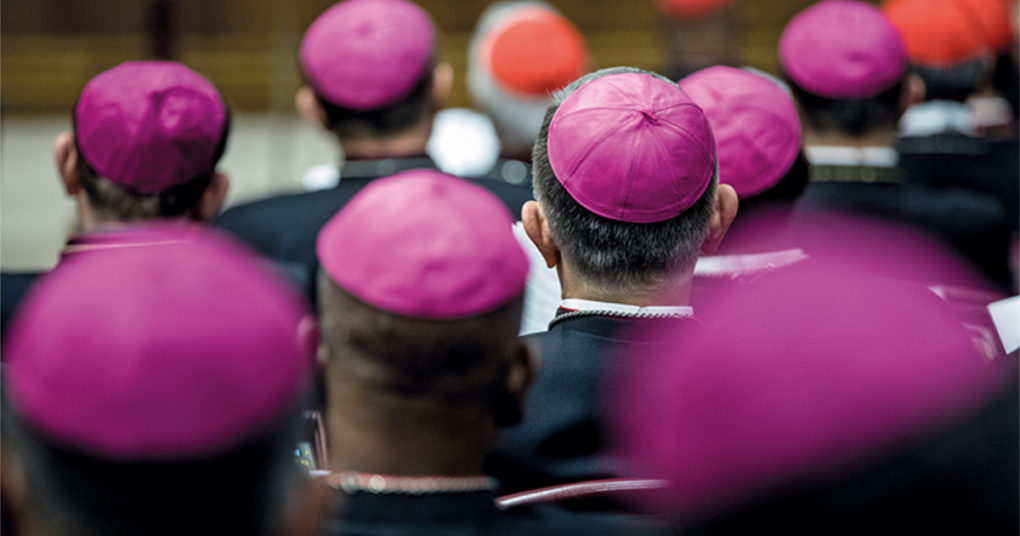When Bishops Meet. An Essay Comparing Trent, Vatican I, and Vatican II
John W. O’Malley.
Harvard University Press (2019)
192 pages
This is a magnificently bound little book from the Belknap Press of Harvard University and comes in cardinal red hardback with superb gold inlay – the papal crest, in fact, on the front and spine, making a most attractive tome to carry around in one’s pocket and dip in and out of particularly in pubic places thus enhancing one’s intellectual commitment to erudition, scholarship and rare books because it already looks like one.
As this is an essay, it eschews footnotes and bibliographies in favour of an easy-to-read account of the author’s intention, which is to provide a commentary on the three modern Church councils as per the title.
Helpfully the author provides three parts to this extended essay, namely the “Three Great Issues” (What do Councils Do?, Does Church Teaching Change? and Who Is in Charge?). “Participants’ (Popes and Curia, Theologians, Laity and The Other), and “Impact and Future” (What Difference Did the Councils Make?, Will There Be Another One?).
The author naturally refers to his previously published and more scholarly works on each of these Councils. He makes the claim that this book is unique since it has a distinct methodology in that it considers the councils synchronically rather than, as usual, diachronically.
Interesting points are many such as that Trent had a lasting influence on the Catholic Church but was credited for things it never did. There is the important point that councils moved to Rome, and in Vatican I made the claim of papal infallibility to counter the effect of the Enlightenment and the French Revolution to provide security and stability to the resulting chaos and anarchy affecting Reason itself.
This is a vital point that is not often made so it is refreshing to see it here. Vatican II is presented as a new way of being a council because it wanted to engage with the outside world.
There have been twenty-one councils which are generally considered ecumenical, that is, church-wide, as being most important. Trent continued the form of legislative and judicial meetings in order to promote good ecclesial order, especially as regards doctrine, and to this end it issued over 250 canons as a counter to the charges made by Luther but it was not convened to condemn him; instead reconciliation was sought. In the end, certain issues were condemned but persons were not and no one was named and shamed, as it were.
Three centuries later Vatican I was cut short due to the seizure of Rome in 1870 by the forces of the new Kingdom of Italy and dealt with only two matters: the dogmatic constitution, Dei Filius on the faith-reason relationship in response to modern rationalism and atheism, and the nature of the papacy in Pastor Aeternus due, in part, to the desire to have a strong, universal papal monarchy to restore ecclesial, and indeed Western, social order. This council, unusually, had issued no disciplinary canons and never got to address other matters due to its relatively sudden curtailment.
Vatican II was, by contrast to its immediate two predecessors, almost wholly positive and abandoned the usual legislative-judicial model for something new, as countenanced by Pope John XXIII, and so the language it used was also new. No canons were issued at all.
Instead this council provided ideals and values to live up to and its final sixteen documents are the product of committees and not a single author and this the author calls a “panegyric form/genre”. Essentially, this means that it adopted a mode of discourse aimed at reconciliation which sought the good things in other institutions and religions.
What was new was that this council redefined the purpose of councils as an opportunity to explore various important issues and to encourage the best instincts of persons and their aspirations. Hence the relationship between the bishops and Pope using collegiality, non-Western cultures in its decree on the liturgy, other Christian and non-Christian religions and non-believers, as well as the modern world itself, were the subjects of its reconciling agenda.
The council appealed not to the judicial model of obedience to external authority but to a higher locus of that, namely interior authority. This gave the Church a new identity as a forum for reconciliation.
This essay pinpoints the centrality of the role of bishops in all three councils and how they have functioned in each, especially by providing continuity across the centuries. Not only bishops, though, but others present, such as theologians, have exerted profound influence on the Catholic Church, as well as lay people whose insights have been invaluable even if they were not in the council chamber.
The author leaves us in no doubt as to the Second Vatican Council being new, unique and superseding the two councils that went before, and thus pointing the way for the future.
About the Author: James Campbell SJ
James Campbell SJ, BSc, MA(Oxon), LLM, Phd is currently the Chief Librarian and Senior Lecturer in Canon Law at Hekima University College, Nairobi. He read Philosophy, Politics and Economics at Oxford and holds an LL.M. from Cardiff Law School and a joint PhD/JCD Doctorate in Canon Law from the University of Louvain.

